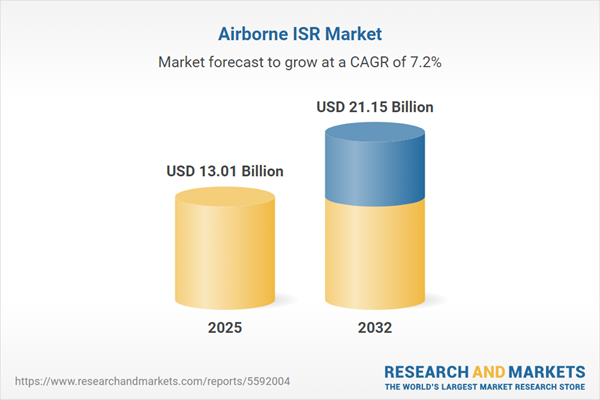Speak directly to the analyst to clarify any post sales queries you may have.
The Airborne ISR Market is experiencing accelerated transformation as advanced technologies and evolving threat environments reshape global strategic and operational landscapes. Senior leaders seek clear guidance and insight to navigate growth opportunities, adapt procurement strategies, and drive mission effectiveness within this high-stakes sector.
Market Snapshot: Airborne ISR Market Size, Growth, and Trajectory
The Airborne ISR Market grew from USD 12.13 billion in 2024 to USD 13.01 billion in 2025. It is expected to continue growing at a CAGR of 7.19%, reaching USD 21.15 billion by 2032. This expansion is underpinned by a combination of increasing defense expenditures, enhanced demand for real-time situational awareness, and the drive to modernize surveillance capabilities across both public and private sector entities worldwide.
Scope & Segmentation
The report provides detailed insights across the full breadth of the airborne intelligence, surveillance, and reconnaissance ecosystem, including:
- Platform Type: Manned aircraft and a diverse range of unmanned aerial vehicles, such as fixed wing UAVs (high, medium, and low altitude), hybrid VTOL UAVs, and rotary wing UAVs (multi rotor, single rotor).
- System Type: Communication systems, data link systems, and mission management systems supporting embedded command and control.
- Sensor Type: Portfolio spanning electro-optical/infrared (long wave, mid wave, short wave), laser designators, advanced radar (Doppler, ground penetrating, synthetic aperture), and SIGINT systems (COMINT, ELINT).
- Application: Solutions tailored for battlefield surveillance, border surveillance (coastal, land), environmental monitoring, and maritime surveillance (offshore patrol, port security).
- End User: Civil government agencies, defense agencies, homeland security agencies, and private sector organizations.
- Region: In-depth geographic coverage of Americas (North America, Latin America), Europe, Middle East & Africa (Europe, Middle East, Africa), and Asia-Pacific, detailing developments in countries such as the United States, Canada, China, India, Japan, and others.
- Leading Companies: Profiles and analyses of key industry players including Lockheed Martin, Northrop Grumman, Raytheon Technologies, Boeing, BAE Systems, QinetiQ, L3Harris Technologies, Leonardo, Thales Group, Elbit Systems, and Saab.
Key Takeaways for Senior Decision-Makers
- Operational agility is increasingly driven by advancements in autonomous platforms, embedded analytics, and secure communication frameworks, ensuring faster, data-driven decisions.
- Shifts toward open architecture and modular payload designs are streamlining integration timelines and enabling rapid upgrades to maintain mission flexibility and readiness.
- Regional variations in technology adoption reflect unique geopolitical pressures, with emerging collaborations driving the establishment of integrated ISR supply chains and manufacturing hubs.
- The convergence of AI, persistent surveillance technologies, and improved sensor fusion is transforming mission planning, real-time intelligence gathering, and collaborative operations across domains.
- Vendor differentiation is defined by proven resilience against electronic and cyber threats, as well as the ability to deliver holistic, interoperable solutions tailored to diverse operational needs.
Tariff Impact: Navigating New Challenges in Procurement and Supply Chain
The introduction of 2025 U.S. tariff measures has significantly influenced global airborne ISR supply chains. Original equipment manufacturers and suppliers are recalibrating sourcing strategies, resulting in more complex and extended procurement processes. These regulatory and economic pressures are accelerating investment in production automation, additive manufacturing, and joint procurement initiatives, while stimulating multinational alliances to buffer against changing trade policies and reduce overreliance on single-source suppliers.
Methodology & Data Sources
This report employs a hybrid research methodology. Primary interviews with senior executives and acquisition experts are supported by secondary analysis of government publications, patent filings, and industry literature. Quantitative market modeling uses both bottom-up and top-down approaches, with scenario-based forecasts tested for resilience under various geopolitical and market-triggered changes.
Why This Report Matters
- Enables procurement leaders and strategy teams to benchmark current capabilities and assess where tactical investments can deliver operational advantage.
- Guides stakeholders navigating evolving international trade environments, supporting the development of resilient and adaptive supply chain strategies.
- Equips decision-makers with actionable segmentation and competitor insight to inform roadmap planning and optimize future acquisition programs.
Conclusion
The Airborne ISR Market is redefining the defense and security intelligence paradigm worldwide. Effective adoption of advanced technologies, modular architectures, and strategic partnerships will empower organizations to respond to emergent challenges and sustain competitive advantage across regions and applications.
Additional Product Information:
- Purchase of this report includes 1 year online access with quarterly updates.
- This report can be updated on request. Please contact our Customer Experience team using the Ask a Question widget on our website.
Table of Contents
3. Executive Summary
4. Market Overview
7. Cumulative Impact of Artificial Intelligence 2025
List of Figures
Samples

LOADING...
Companies Mentioned
The key companies profiled in this Airborne ISR market report include:- Lockheed Martin Corporation
- Northrop Grumman Corporation
- Raytheon Technologies Corporation
- The Boeing Company
- BAE Systems PLC
- QinetiQ Limited
- L3Harris Technologies, Inc.
- Leonardo S.p.A.
- Thales Group
- Elbit Systems Ltd.
- Saab AB
Table Information
| Report Attribute | Details |
|---|---|
| No. of Pages | 180 |
| Published | October 2025 |
| Forecast Period | 2025 - 2032 |
| Estimated Market Value ( USD | $ 13.01 Billion |
| Forecasted Market Value ( USD | $ 21.15 Billion |
| Compound Annual Growth Rate | 7.1% |
| Regions Covered | Global |
| No. of Companies Mentioned | 12 |









